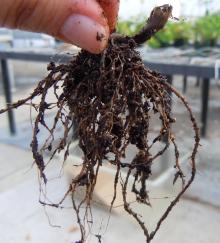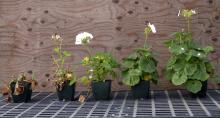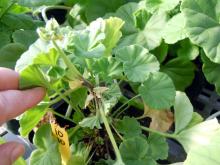By J. Weiland and L. Santamaria
Cause Pythium species are common soilborne pathogens that infect seeds and roots of many greenhouse crops. Some of the more common species include P. aphanidermatum, P. cryptoirregulare, P. irregulare, and P. ultimum, but other species may also be present. All Pythium species are strongly favored by abundant moisture and can be especially problematic in poorly drained potting media. Pythium usually attacks seeds or seedlings in the greenhouse. However, cuttings and older plants may also be affected, especially if the potting media is too wet or placed on a poorly-drained surface. Substrate temperatures above 77°F favor the development of some Pythium spp. such as P. aphanidermatum.
Pythium spp. can survive in dust, planting media, or soil particles on greenhouse floors, flats, and pots. Wood benches can also be a reservoir. Spread can also occur via movement of infected plants. Damaged plants are more easily infected. It enters roots damaged by high soluble salts, either from over-fertilization or from letting the rooting medium dry out, even for short periods, during propagation.
Cold irrigation water greatly slows growth for a few hours following each watering and will prolong the maturation period and lengthen the time during which plants are susceptible to damping-off.
Symptoms First symptoms often include poor seed germination and emergence referred to as damping-off. Seeds become soft, shrivel, and disintegrate. If germination occurs, very young, small seedlings appear to suddenly collapse and die. Older seedlings develop brown to gray, water-soaked lesions at or below the soil line. Often the lower part of the stem withers before the upper stem and leaves causing infected seedlings to fall over on top of the soil. Disease progression can be very rapid and spread to adjacent healthy seedlings. In extremely moist conditions, white cottony fungal growth may appear on the surface of the seedlings and the soil.
Cuttings rot from the base and roots may fail to develop. Occasionally, roots will develop immediately above the rotted area where the rooting medium is drier.
Older plants can appear stunted or chlorotic, and may wilt even when enough water is available for growth. Diseased roots are discolored brown and/or appear water soaked. Fine roots turn mushy and slough off leaving mostly thicker, older roots behind. The root cortex of the smaller roots can often be easily slipped off, thus leaving a white cylinder of vascular tissue behind.
Cultural control Good greenhouse hygiene will help reduce risk of these diseases. Make cleanliness a priority. Avoid disease-promoting conditions such as poor sanitation, inadequate drainage, and inappropriate irrigation.
- Always use disease-free planting materials. If cuttings are used for propagation, obtain them only from healthy plants. If stock plants are in the field, avoid taking cuttings from branches close to the ground, as these could be contaminated.
- Rooted plants acquired from other nurseries should be inspected and placed in a quarantine area where they can be held and monitored for disease development for a few weeks.
- Cuttings acquired from other nurseries should be inspected, disinfested and planted as soon they arrive.
- Use new pots, trays, or treat any reused items with a disinfectant, use steam, or solarization techniques (such as with anti-condensation film) to clean them.
- Use soilless growing media that is stored under cover in a concrete bay or in some other clean and sealed container kept dry, cool, and in a low-light environment.
- Growing media could be treated by steam (140°F for 30 minutes), solarization (double-tent at 160°F for 30 minutes or 140°F for 1 hour), or chemically. Storage area surfaces should be easy to clean and disinfest. This could include metal or plastic bins, trailers, trolleys, in bags on a sealed surface, or racks under cover.
- Use ground sources for irrigation and avoid surface water sources for propagation of the crop.
- Good drainage and water management are essential components of a management plan. Ensure growing media and holding areas are well drained.
- Avoid soil moisture conditions of 70% or higher.
- Do not over-fertilize or let plants dry out. Monitor soluble salt concentrations regularly.
- Avoid rough handling of plants, especially when starting and ending the crop.
- Remove diseased plants immediately and carry out rigorous hygiene measures to prevent further spread.
- Remove crop residue and old or low-quality plants that will not be marketed as they can become sources of inoculum.
- Replace wood benches or potting tables for ones made of plastic or wire that will facilitate cleaning and disinfestation.
- Regularly sterilize any tools used in propagation or pruning using 70% alcohol solution or quaternary ammonium-based products.
For subirrigation systems:
- Subirrigation systems (ebb-and-flow benches, trough benches, capillary mats, and collection trays) tend to accumulate salts in the growth medium so it is critical to test EC and pH regularly.
- Remove dead material from growing areas, inside tanks, and plumbing on a regular basis. Disinfect the system after each crop.
- Disinfestants should be used on regular basis as part of a pre-crop clean up program and during the cropping cycle. Check for disinfestants that can be used in subirrigation systems.
Chemical control Fungicides are best used as protectants in combination with cultural controls. Once symptoms are observed, the disease is difficult to control. Therefore, prevention is key. Rotate among fungicides with different modes of action to help prevent fungicide resistance from developing. Be sure to check labels for crop safety before application.
- Adorn at 1 to 4 fl oz/100 gal water plus another fungicide. Group 43 fungicide. 12-hr reentry.
- Banol at 2 to 3 fl oz/10 gal water. Group 28 fungicide. 12-hr reentry.
- Banrot 40 WP at 6 to 12 oz/100 gal water. Group 1 + 14 fungicide. 12-hr reentry.
- Disarm 480 SC at 0.15 to 0.6 fl oz/100 gal water. 12-hr reentry.
- Empress at 1 to 3 fl oz/100 gal water can be used for cuttings or seedlings. Group 11 fungicide. 12-hr reentry.
- Fenstop at 7 to 14 fl oz/50 to 100 gal water. Use 1 to 2 pints/sq ft. For greenhouse use only. Group 11 fungicide. 12-hr reentry.
- Fosphite at 1 to 2 quarts/100 gal water. Do not use copper products within 20 days of treatment and do not use spray adjuvants. Group P7 fungicide. 4-hr reentry.
- Heritage at 0.45 to 1 oz/100 gal water as a drench application. Group 11 fungicide. 4-hr reentry.
- Mefenoxam 2 AQ at 0.49 to 0.98 fl oz/100 gal water as a soil drench, see label for media incorporation. Resistant isolates of the fungus have been detected in the Northeast United States. Group 4 fungicide. No restrictions on reentry when used as a soil drench or media incorporation.
- OxiPhos at 1.3 to 4 quarts/100 gal water as a foliar spray. Group P7 fungicide. 4-hr reentry.
- Pro-Mix BX (Bacillus pumilus strain GHA180) is sphagnum peat moss, perlite, vermiculite, dolomitic limestone and calcitic limestone with the bacteria already incorporated into the mix. The mycorrhizae fungus Glomus intraradices is also incorporated for enhanced nutrient uptake. 0-hour reentry.
- Proplant at 2 to 3 fl oz/10 gal water. Group 28 fungicide. 12-hr reentry.
- Segway SC at 1.5 to 3 fl oz/100 gal water. Drench rate is based on pot diameter. 12-hr reentry.
- Subdue MAXX at 0.5 to 1 fl oz/100 gal water. Use 1 pint solution/sq ft. Resistant isolates of the fungus have been detected in the Northeast United States. Group 4 fungicide. 48-hr reentry. No restrictions on reentry when used as a soil drench.
- Terrazole 35 WP at 3.5 to 10 oz/100 gal water. Group 14 fungicide. 12-hr reentry.
- Truban 30 WP at 3 to 10 oz/100 gal water. Group 14 fungicide. 12-hr reentry.
Biological control Several studies have shown the effectiveness of some strains of Trichoderma spp. to control or improve suppression of Pythium and other oomycetes in ornamental crops under greenhouse conditions. Use in conjunction with other control tactics such as thorough sanitation.
- Actinovate SP (Streptomyces lydicus strain WYEC 108) at 6 oz/100 gal water as a soil drench. Do not mix with Regalia or certain copper- or sulfur-based products. 4-hr reentry. O
- Asperello T34 (Trichoderma asperellum strain T34) at 0.35 oz/35 sq ft of substrate before potting. Do not mix or use with other fungicides for 10 days. See label for details. 12-hr reentry. O
- Bexfond (Bacillus amyloliquefaciens subspecies plantarum strain FZB42) at 0.5 fl oz/10 gal water is registered as a drench. Use 3 to 9.5 fl oz/sq ft. Unknown efficacy in the PNW. Group BM02 fungicide. 4-hr reentry. O
- Bio-Tam 2.0 or Tenet WP or Obtego (Trichoderma asperellum and T. gamsii) at 0.5 to 1.5 lb/cubic yard of substrate. See label for details and other application methods. No restrictions on reentry when soil incorporated. O
- LALStop G46 WG (Clonostachys rosea [formerly Gliocladium catenulatum] strain J1446) at 0.33 oz/5 gal water. Do not use with other products in the tank.4-hr reentry. O
- LALStop K61 WP (Streptomyces Strain K61) at 0.07 oz/100 to 200 sq ft. Apply with enough water to move product into the root zone. Can be used as a soil spray, drench, dip or incorporated into potting media. 4-hr reentry. O
- Mycostop (Streptomyces Strain K61) at 1 to 2 grams/100 sq ft. Apply with enough water to move product into the root zone. Can be used as a soil spray, drench, dip or incorporated into potting media. 4-hr reentry. O
- PlantShield HC (Trichoderma harzianum Rifai strain T-22) at 3 to 5 oz/100 gal water as a soil drench. 4-hr reentry. O
- RootShield Plus Granules (Trichoderma harzianum Rifai strain T-22 and T. virens strain G-41) at 1 to 3 lb/ cubic yard soil mix or at 0.5 to 7.5 lb/1,000 sq ft. No restrictions on reentry required when soil incorporated.O
- SoilGard (Gliocladium virens strain GL-21) at 2 to 4 oz/100 gal water. Unknown efficacy in the PNW. Group BM02 fungicide. 4-hr reentry. O
- Stargus (Bacillus amyloliquefaciens strain F727) at 2 to 4 quarts/100 gal water plus a nonionic surfactant as a soil drench. Weekly applications were effective in one hydrangea trial. Group BM02 fungicide. 4-hr reentry. O
- Subtilex NG (Bacillus subtilis stain MBI 600) at 0.2 to 0.4 oz/100 gal is registered as a drench. Unknown efficacy in the PNW. Group BM02 fungicide. 4-hr reentry. O
- Triathlon BA (Bacillus amyloliquefaciens strain D747) at 0.5 to 6 quarts/100 gal water. Group BM02 fungicide. 4-hr reentry. O
- Zio (Pseudomonas chlororaphis strain AFS009) at 6.7 to 10 oz/10 gal water as a soil drench. Unknown efficacy in the PNW. 4-hr reentry. O
References Liu, W., Sutton, J.C., Grodzinski, B., Kloepper, J.W., and Reddy, M.S. 2007. Biological control of Pythium root rot of Chrysanthemum in small-scale hydroponic units. Phytoparasitica 35: 159-178.
Weiland, J.E., Santamaria, L., and Grunwald, N.J. 2014. Sensitivity of Pythium irregulare, P. sylvaticum, and P. ultimum from forest nurseries to mefenoxam and fosetyl-Al, and control of Pythium damping-off. Plant Disease 98: 937-942.




